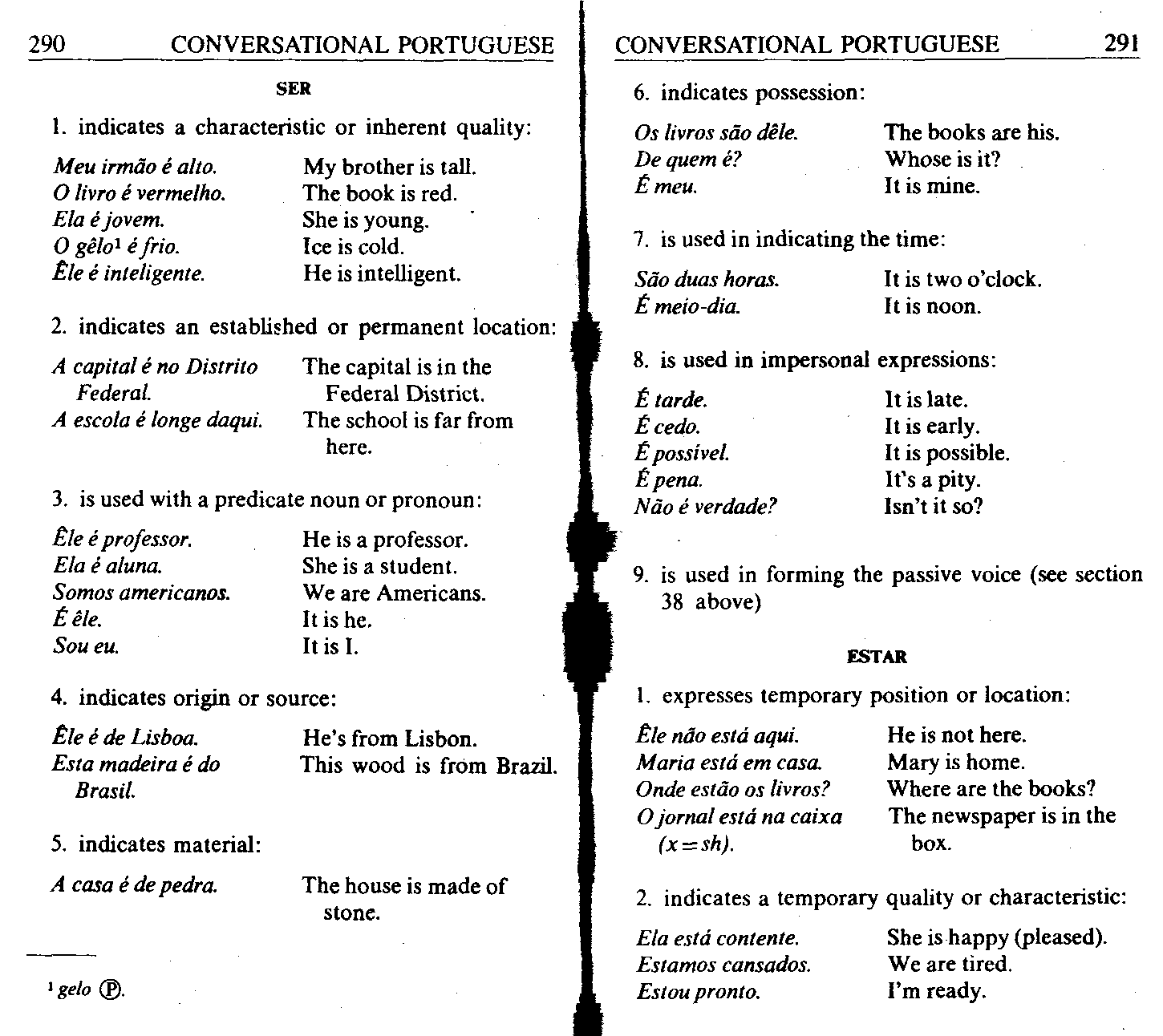Summary p290

290 CONYERSATIONAL PORTUGUESE
SER
1. indicates a characteristic or inherent ąuality:
My brother is tali. The book is red. She is young.
Ice is cold.
He is intelligent.
2. indicates an estabUshed or permanent location:
A capital e no Distrito The Capital is in the
Federai Federal District.
A escola e longe daąui. The school is far from
here.
3. is used with a predicate noun or pronoun:
źle e professor.
Ela e aluna.
Somos americanos. Żele.
Sou eu.
He is a professor. She is a student. We are Americans. Itishe.
It is I.
4. indicates origin or source:
źle i de Lisboa. He’s from Lisbon.
Esta madeira e do This wood is fróm Brazil.
Bras ii
5. indicates materiał:
A casa e de pedra. The house is madę of
stone.
|
6. indicates possession: | |
|
Os łivros sao dele. |
The books are his. |
|
De quem e? |
Whose is it? |
|
£ meu. |
It is minę. |
|
7. is used in indicating the time: | |
|
Sao duas horas. |
It is two o’clock. |
|
£ meio-dia. |
It is noon. |
|
8. is used in impersonal |
expressions: |
|
£ tarde. |
It is late. |
|
£ cedo. |
It is early. |
|
£ posswel. |
It is possible. |
|
£ pena. |
It1 s a pity. |
|
Nao e verdade? |
Isn’t it so? |
9. is used in forming the passive voice (see section 38 above)
ESTAR
1. expresses temporary position or location:
źle nao estd aqui.
Maria estd em casa.
Onde estao os livros?
O jornal estd na caixa (x—sh),
2. indicates a temporary
Ela estd contente, Estamos cansados.
Estou pronto.
He is not here.
Mary is home.
Where are the books? The newspaper is in the box.
ąuality or characteristic:
She is happy (pleased). We are tired.
I'm ready.
gelo 0.
Wyszukiwarka
Podobne podstrony:
Summary p270 270 CONYERSATIONAL PORTUGUESE 2. to indicate a condition, or action
Summary p222 222 CONYERSATIONAL PORTUGUESE 21. Vamos_(to have dinner). a. jantar
Summary p224 224 CONYERSATIONAL PORTUGUESE (3) variations occur in different areas: a.
Summary p226 226 CONYERSATIONAL PORTUGUESH CONYERSATIONAL PORTUGUESE 227 d g g h j I I Ut m as d i
Summary p230 230 CONYERSATIONAL PORTUGUESE 3, The cedilla (cedilha) is used with
Summary p234 234 CONYERSATIONAL PORTUGUESE k. with parts of the body and articles of clothing inst
Summary p236 236 CONYERSATIONAL PORTUGUESE De and em combine with the demonstrative forms (see GS2
Summary p238 238 CONYERSATIONAL PORTUGUESE 13. MASCULINE AND FEMININE 238 CONYERSATIONAL PORTUGUES
Summary p240 240 CONYERSATIONAL PORTUGUESE 14. THE PLURAL 1. Nouns ending in a vowel, including na
Summary p242 242 CONYERSATIONAL PORTUGUESE seu can also be used to translate “his,” “her,” “their.
Summary p246 246 CONYERSATIONAL PORTUGUESE 1«. COMPAR1SON 1. Rcgular comparison facil easy ma
Summary p248 248 CONYERSATIONAL PORTUGUESE 19. PRONOUNS Pronouns have varying forms depending on w
Summary p250 250 CONYERSATIONAL PORTUGUESE CONYERSATIONAL PORTUGUESE_ 251 (te) I
Summary p254 254 CONYERSATIONAL PORTUGUESE Nao me escreva mais. Eles decidiram que nos mandar
Summary p256 256 CONYERSATIONAL PORTUGUESE 21. SOME CONJUNCTIONS ainda que assim que ate
Summary p258 258 CONYERSATIONAL PORTUGUESE 23. ADYERBS 1. Some Portuguese adverbs are formed by ad
Summary p260 260 CONYERSATIONAL PORTUGUESE la (acold) there (morę remote) adiante . forward,
Summary p262 262 CONYERSATIONAL PORTUGUESE sabdo soap sabonete a cake of toilet
Summary p264 264 CONYERSATIONAL PORTUGUESE Ndo ąuero este sem I don’t want this one
więcej podobnych podstron